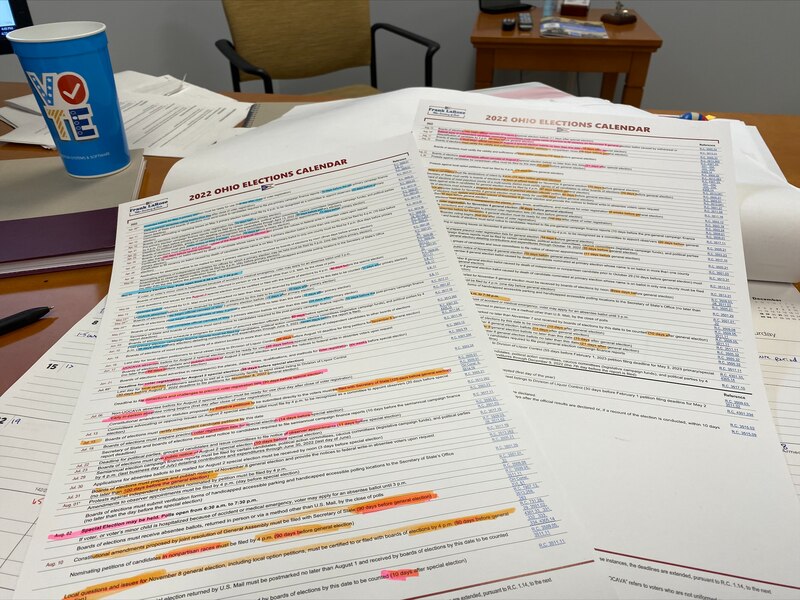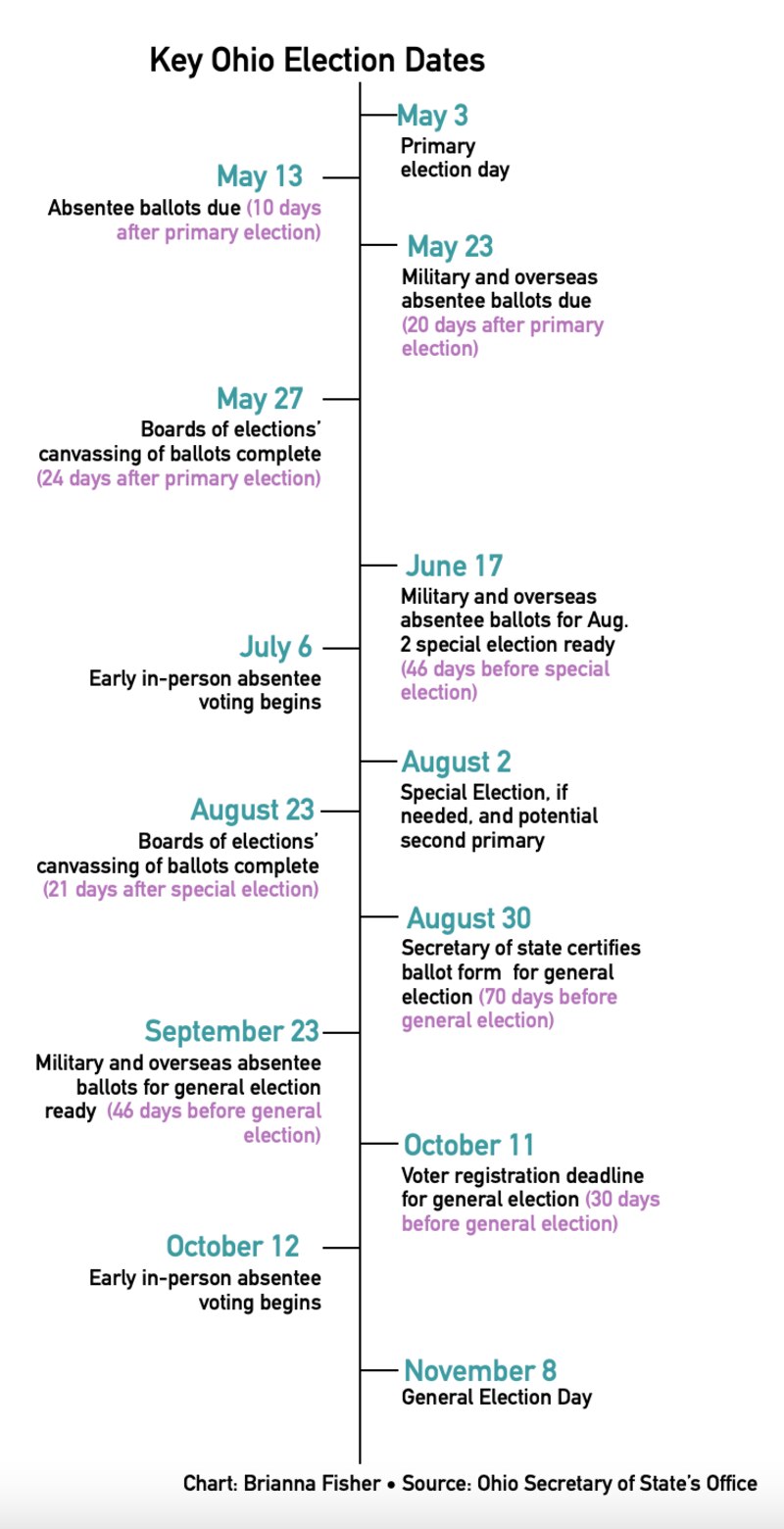A version of this post was originally distributed in Votebeat’s weekly newsletter. Sign up here.
Tuesday was the Ohio primary — well, the first one.
If you’re curious why Ohio has to have two separate primaries this year (answer: the state’s ongoing redistricting disaster), then you’re probably wondering when the second one will be held.
So are election officials and Ohio voters! That’s right — no one really knows. The state Supreme Court has repeatedly ruled version after version of the congressional and state legislative maps unconstitutional, leaving election officials in limbo, and facing increasingly difficult-to-meet deadlines.
The past few years have proven that election officials bring order to chaos by having many, many backup plans, complete with checklists, color-coded calendars, and, when necessary, creative solutions manufactured from items purchased at a local dollar store. But there are limits.
Ohio is one example of what voters and election officials are dealing with around the country. In state after state, court cases and new voting laws — often crafted by lawmakers who don’t consider practical implications — are making elections even more complicated to administer and are confusing voters.
Ohio election officials and advocates for voters, reacting to the state’s slow start on redistricting, asked the Legislature to delay the primary in hopes of having maps in place for one single election, but legislators didn’t do it.
“All the challenges with timing could have been avoided if the redistricting commission and the Ohio General Assembly were proactive from the get go,” said Jen Miller, executive director of the League of Women Voters of Ohio, which sued over the redistricting maps, “instead of intentionally running out the clock as a strategy for forcing gerrymandered maps on the people of Ohio.”
The May 3 primary was based on a congressional map that is still being disputed in court. Statewide races, unaffected by redistricting, were also on this ballot. State legislative maps are still in limbo, which is why the state will need to have a second primary, with the costs borne by Ohio taxpayers.
Election officials, and Ohio Secretary of State Frank LaRose, a Republican, have said it will be extraordinarily difficult to schedule the second primary for any date other than Aug. 2, when some jurisdictions are already scheduled to hold special elections.
If the election isn’t Aug. 2, “this is going to get crazy and it makes my head spin thinking about it,” said Aaron Ockerman, executive director of the Ohio Association of Election Officials.
The state’s election calendar, based on its laws, calls for an election on Aug. 2 to be certified by Aug. 23 — just one month before military and overseas ballots for the general election have to be ready.
The state Supreme Court, for its part, pointed out that plenty of states have primaries after Aug. 2, and called it an “artificial deadline.”
A federal court then said that if Ohio doesn’t have a map in place by May 28, it will order the implementation of one the Ohio Supreme Court previously ruled unconstitutional and set the election for Aug. 2. The courts cannot wait longer “without jeopardizing the right to vote, overriding a host of state election laws and deadlines, and inviting the electoral chaos and confusion that the U.S. Supreme Court has repeatedly instructed lower courts to avoid,” a three- judge panel wrote.
The judges said they chose that map because nearly all 88 counties had already at least begun programming those new legislative districts into their systems.
The delays already have left fatigued election officials enmeshed in a series of overlapping elections, struggling to meet deadlines set by state law and waiting for certainty.

In Montgomery County, Ohio’s fifth largest, putting the new maps in place required a team of people working for days. All that work had to be scrupulously and repeatedly checked.
“We cannot make mistakes,” said Sarah Greathouse, deputy director of the Montgomery County Board of Elections.
If Ohio ultimately adopts a different state legislative map than the one the federal court is preparing to put in place, that work will have to be redone. The difficulty of the task varies by county, depending on the number of changes and how many different districts the county is divided between.
Meanwhile, the tight timeframes for the May 3 election caused delays that foreshadow what election officials must contend with for the second primary.
Election officials are legally required to have ballots ready to send to military and overseas voters 46 days before the election date. With the disputed congressional maps coming down to the wire, they couldn’t finalize the ballots on time.
In Clinton County in southwest Ohio, which touts itself as the birthplace of the banana split, election officials crafted multiple versions of the ballot, based on old and new districts, hoping to be ready for any circumstance when finally allowed to move forward. “Voting started on Tuesday and on [the Friday before] we got notification from the secretary of state” to go ahead and place the ballot order, said Shane Breckel, the county’s elections director.
The state used grant money to pay the bill for express postage for military and overseas ballots this time, and some ballots cost more than $100 in postage, said Brian Sleeth, director of Warren County’s Board of Elections.
If the next election is Aug. 2, those military and overseas ballots must be ready for use by June 17 — just a few weeks after the deadline to finalize the May 3 election results. Early voting — which begins 28 days before the election in Ohio — would start July 6.

Finalizing ballots isn’t simple or fast. In Cuyahoga County, Ohio’s largest, there are 975 precincts, and each precinct essentially had its own distinct ballot for the May 3 election — for both parties — said Anthony Perlatti, director of the county board of elections.
When Cuyahoga County produced a test deck for the May 3 ballot, to ensure its machines could properly tally every possible ballot choice and flag design issues before ordering the full print run, it ran to more than 50,000 sheets of paper.
For the May primary, the 400 Cuyahoga voters who cast ballots during the first three days of early voting had to mark their choices on an unofficial copy of the ballot that was placed into a secure envelope because the actual ballots weren’t ready yet. A bipartisan team later opened the envelope and replicated the voter’s choices on a real ballot, so it could be tallied.
Meanwhile, Sleeth, president of the Ohio election administrators association, is concerned about lining up polling places and poll workers for the next election, which still has no certain date.
At least, he said, the county always tells polling places and poll workers there is the possibility of an election on Aug. 2, which means they are more likely to be available than on another random date.
If the county has to scramble for replacement polling places and notify voters over the summer, he said, “it just adds so much confusion.”
Even when polling places don’t change, Cuyahoga’s Perlatti said his office typically sends voters a card in English and Spanish that lists their polling place, the hours of early voting, and directions to request a mail ballot.
Not this time. Until late March, officials weren’t sure the courts would permit the May 3 election to go forward. That meant no card.
Usually, “we know when it hits people’s mailboxes because our website and our phones blow up” with people requesting mail ballots, he said.
In 2018 and 2014, Perlatti said, the county had around 70,000 voters request mail ballots for the primary. As of the Thursday before the May 3 election, the county had only about 32,000 such requests. Perlatti said he believes a “good portion” of the difference is because voters didn’t get that card.
Some of those voters cast ballots in person, he said. Others, he is sure, sat out this election.
Are overlapping deadlines, conflicting court rulings, or other issues affecting your ability to plan for a smooth election? Let us know at tips@votebeat.org.
Back Then
These days, voters take it for granted that they’ll receive a printed, government-issued ballot. But it wasn’t always so. Many of the earliest American elections were conducted by voice vote (a practice still in use at some Town Meetings in New England). When voters did start using paper, they often wrote their choices out themselves — hopefully legibly. In the early 19th century, candidates and parties began providing ballots, sometimes with eye-catching and colorful designs, The New Yorker reported. It wasn’t until the late 19th century that states began adopting the so-called “Australian ballot” or “blanket ballot,” a government-issued ballot that listed all candidates, regardless of party, and allowed for private voting, but presented barriers for voters who couldn’t read.
In Other Voting News
- The dramatic leak of a draft Supreme Court opinion that would overturn landmark abortion rights ruling Roe v. Wade is prompting fresh scrutiny of the Supreme Court confirmation process and whether past nominees were truthful about how they viewed precedents, the Washington Post reported. That’s something that could have implications for long-standing precedents concerning other rights.
- A federal appeals court Friday struck down a lower court’s stay of certain provisions in Florida’s new election law, and also halted the portion of the order that had required the state to seek federal permission before enacting new laws regulating absentee ballot drop boxes, third-party voter registration efforts, and so-called “line warming.”
- President Trump’s acting Homeland Security secretary, Chad Wolf, delayed an intelligence report on Russian targeting of Democratic presidential candidates before the 2020 election, creating a perception of politicization, an investigation by the Homeland Security inspector general found, Defense One reported.
- It’s not just Ohio: New York will likely have to hold two separate primary elections, in June and August, after courts ruled redistricting maps violated a partisan gerrymandering ban in the state Constitution, creating confusion among voters and millions of dollars in costs to taxpayers.
- CNN reports on how new voting restrictions around the country are making it harder for disabled voters to cast ballots.
- The backlash against mail-in voting is even reverberating in deep-red Utah, where it’s the primary way to vote in most counties.
- A special grand jury in Fulton County, Georgia, will weigh whether former President Donald Trump and his associates violated the law when pressuring election officials, including Secretary of State Brad Raffensperger, in connection with the 2020 election results, the Atlanta Journal-Constitution reported.
- Termites are threatening a historic Selma, Alabama church known for its role in the voting rights movement.
Carrie Levine is Votebeat’s story editor and is based in Washington, D.C. Contact Carrie at clevine@votebeat.org.






